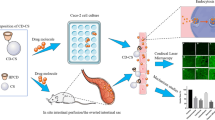Abstract
Purpose. Chitosan has recently been demonstrated to effectively enhance the absorption of hydrophilic drugs such as peptides and proteins across nasal and intestinal epithelia (1–3). In this study, the effect of the chemical composition and molecular weight of chitosans on epithelial permeability and toxicity was investigated using monolayers of human intestinal epithelial Caco-2 cells as a model epithelium.
Methods. Eight chitosans varying in degree of acetylation (DA) and molecular weight were studied. The incompletely absorbed hydrophilic marker molecule 14C-mannitol was used as a model drug to assess absorption enhancement. Changes in intracellular dehydrogenase activity and cellular morphology were used to assess toxicity.
Results. Chitosans with a low DA (1 and 15%) were active as absorption enhancers at low and high molecular weights. However, these chitosans displayed a clear dose-dependent toxicity. Chitosans with DAs of 35 and 49% enhanced the transport of 14C-mannitol at high molecular weights only, with low toxicity. One chitosan (DA = 35%; MW = 170kD) was found to have especially advantageous properties such as an early onset of action, very low toxicity, and a flat dose-absorption enhancement response relationship.
Conclusions. The structural features of chitosans determining absorption enhancement are not correlated with those determining toxicity, which makes it possible to select chitosans with maximal effect on absorption and minimal toxicity.
Similar content being viewed by others
REFERENCES
L. Illum, N. F. Farraj, and S. S. Davis. Pharm. Res. 11:1186–1189 (1994).
C. O. Rentel, C. M. Lehr, J. A. Bouwstra, H. L. Luessen, and H. E. Junginger. Proceed. Intern. symp. control. Rel. Bioact. Mater. 20:446–447 (1993).
P. Artursson, T. Lindmark, S. S. Davis, and L. Illum. Pharm. Res. 11:1358–1361 (1994).
M. J. Jackson. In L. R. Johnson (ed.), Physiology of the Gastrointestinal Tract. Second edition, Raven Press, New York, 1987, pp. 1597–1621.
J. L. Madara and J. S. Trier. In L. R. Johnson (ed.), Physiology of the Gastrointestinal Tract. Second edition, Raven Press, New York, 1987, pp. 1251–1266.
P. L. Smith, D. A. Wall, C. H. Gochoco, and G. Wilson. Adv. Drug Del. Rev. 8:253–290 (1992).
E. S. Swenson and W. J. Curatolo. Adv. Drug Del. Rev. 8:39–92 (1992).
J. H. Hochman and P. Artursson. J. Control. Rel. 29:253–267 (1994).
K. M. Vårum, M. W. Anthonsen, H. Grasdalen, and O. Smidsrød. Carbohydr. Res. 211:17–23 (1991).
K. M. Vårum, M. W. Anthonsen, H. Grasdalen, and O. Smidsrød. Carbohydr. Res. 217:19–27 (1991).
M. W. Anthonsen, K. M. Vårum, and O. Smidsrød. Carbohydr. Polymers 22:193–201 (1993).
R. J. Nordtveit, K. M. Vårum, and O. Smidsrød. Carbohydr. Polymers 23:253–260 (1994).
A. Domard. Int. J. Biol. Macromol. 9:98–104 (1987).
M. W. Anthonsen and O. Smidsrød. Carbohydr. Polymers 26:303–305 (1995).
C. J. Brine, P. A. Sandford, and J. P. Zikakis. Advances in Chitin and Chitosan, Elsevier Applied Science, London, 1992.
S. W. Chang, J. Y. Westscott, J. E. Henson, and N. V. Voelkel. J. Appl. Physiol. 62:1932–1943 (1987).
H. M. Ekrami and W. C. Shen. J. Drug Target. 2:469–475 (1995).
C. M. Lehr, J. A. Bouwstra, E. H. Schacht, and H. E. Junginger. Int. J. Pharm. 78:43–48 (1992).
K. M. Vårum, M. W. Anthonsen, M. H. Ottøy, H. Grasdalen, and O. Smidsrød. In: C. J. Brine, P. A. Sandford, and J. P. Zikakis (eds.), Advances in Chitin and chitosan, Elsevier Applied Science, London, 1992, pp. 127–136.
P. Artursson. J. Pharm. Sci. 79:476–482 (1990).
K. Lappalainen, I. Jääskeläinen, K. Syrjänen, A. Urtti, and S. Syrjänen. Pharm. Res. 11:1127–1131 (1994).
E. K. Anderberg, C. Nyström, and P. Artursson. J. Pharm. Sci. 81:879–887 (1992).
A. G. DeBoer and D. D. Breimer. In A. G. DeBoer (ed.), Drug Absorption Enhancement: Concepts, Possibilities, Limitations and Trends, Harwood Academic Publishers, Chur, 1994, pp. 155–175.
E. S. Swenson, W. B. Milisen, and W. Curatolo. Pharm. Res. 11:1132–1142 (1994).
E. K. Anderberg and P. Artursson. J. Pharm. Sci. 82:392–398 (1993).
A. Santana, S. Hyslop, E. Antunes, M. Mariano, Y. S. Bakhle, and G. DeNucci. Agents Actions 39:104–110 (1993).
I. Westergren and B. B. Johansson. Acta Physiol. Scand. 149:99–104 (1993).
G. T. A. McEwan, M. A. Jepson, B. H. Hirst, and N. L. Simmons. Biochim. Biophys. Acta 1148:51–60 (1993).
C. J. Bentzel, M. Fromm, C. E. Palant, and U. Hegel. J. Membr. Biol. 95:9–20 (1987).
C. J. Tzan, J. R. Berg, and S. A. Lewis. Am. J. Physiol. 265 (Cell Physiol. 34):C1637–1647 (1993).
Author information
Authors and Affiliations
Rights and permissions
About this article
Cite this article
Schipper, N.G.M., Vårum, K.M. & Artursson, P. Chitosans as Absorption Enhancers for Poorly Absorbable Drugs. 1: Influence of Molecular Weight and Degree of Acetylation on Drug Transport Across Human Intestinal Epithelial (Caco-2) Cells. Pharm Res 13, 1686–1692 (1996). https://doi.org/10.1023/A:1016444808000
Issue Date:
DOI: https://doi.org/10.1023/A:1016444808000




